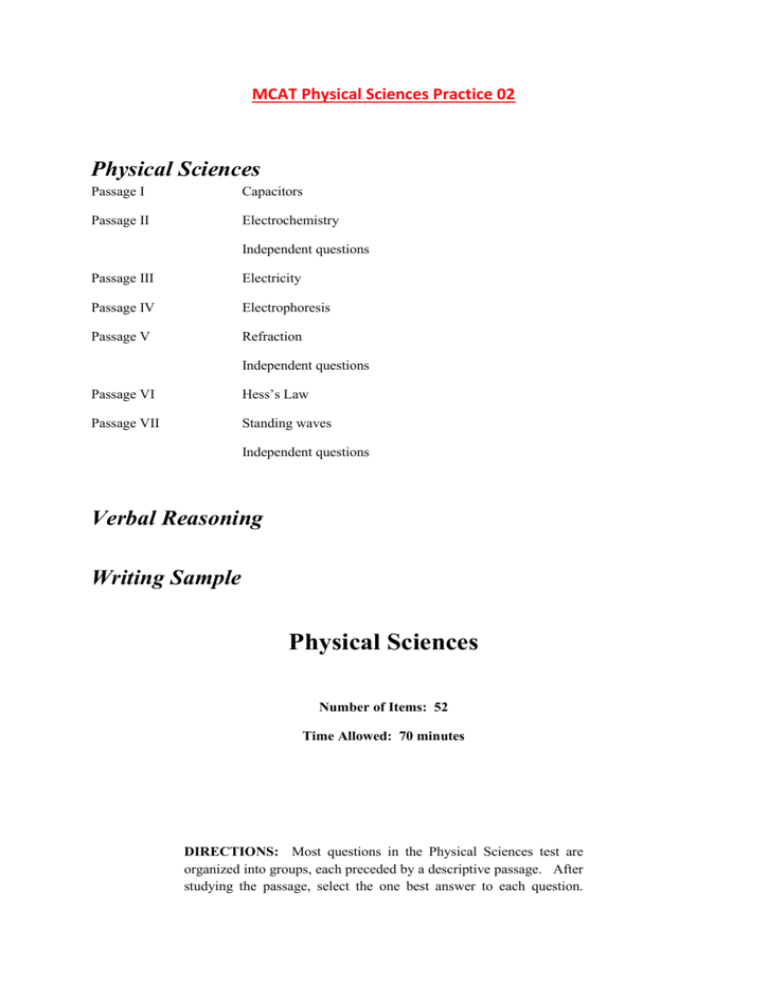MCAT Physical Sciences Practice 02
advertisement

MCAT Physical Sciences Practice 02 Physical Sciences Passage I Capacitors Passage II Electrochemistry Independent questions Passage III Electricity Passage IV Electrophoresis Passage V Refraction Independent questions Passage VI Hess’s Law Passage VII Standing waves Independent questions Verbal Reasoning Writing Sample Physical Sciences Number of Items: 52 Time Allowed: 70 minutes DIRECTIONS: Most questions in the Physical Sciences test are organized into groups, each preceded by a descriptive passage. After studying the passage, select the one best answer to each question. Some questions are not based on a descriptive passage and are also independent of each other. You should also select the one best answer to these independent questions. A periodic table is provided and you may consult it whenever you wish. Periodic Table of the Elements IA IIA IIIA IVA VA VIA VIIA VIIA 1 2 H He 1.0 4.0 3 4 5 6 7 8 9 10 Li Be B C N O F Ne 6.9 9.0 10. 8 12. 0 14. 0 16. 0 17. 0 20. 2 11 12 13 14 15 16 17 18 Na Mg Al Si P S Cl Ar 23. 0 24. 3 27. 0 28. 1 31. 0 32. 1 35. 5 39. 9 19 20 21 22 23 24 25 26 27 28 29 30 31 32 33 34 35 36 K Ca Sc Ti V Cr Mn Fe Co Ni Cu Zn Ga Ge As Se Br Kr 39. 1 40. 1 45. 0 47. 9 50. 9 52. 0 54. 9 55. 8 58. 9 58. 7 63. 5 65. 4 69. 7 72. 6 74. 9 79. 0 79. 9 83. 8 37 38 39 40 41 42 43 44 45 46 47 48 49 50 51 52 53 54 Rb Sr Y Zr Nb Mo Tc Ru Rh Pd Ag Cd In Sn Sb Te I Xe 85. 5 87. 6 88. 9 91. 2 92. 9 95. 9 (98) 101. 1 102. 9 106. 4 107. 9 112. 4 114. 8 118. 7 121. 8 127. 6 126. 9 131. 3 55 56 57 72 73 74 75 76 77 78 79 80 81 82 83 84 85 86 Cs Ba La * Hf Ta W Re Os Ir Pt Au Hg Tl Pb Bi Po At Rn 132. 9 137. 3 178. 5 180. 9 183. 9 186. 2 190. 2 192. 2 195. 1 197. 0 200. 6 204. 2 207. 2 209. 0 (209 ) (210 ) (222 ) 87 88 89 104 105 106 107 108 109 110 111 112 114 116 Fr Ra Ac† Rf Db Sg Bh Hs Mt Ds Uuu Uub Uuq Uuh (223 ) (226 ) (227 ) (261 ) (262 ) (266 ) (264 ) (277 ) (268 ) (281 ) (272 ) (261 ) (289 ) (289 ) 138. 9 * † 58 59 60 61 62 63 64 65 66 67 68 69 70 71 Ce Pr Nd Pm Sm Eu Gd Tb Dy Ho Er Tm Yb Lu 140 140 144 144 150 152 157 158 162 164 167 168 173 175 90 91 92 93 94 95 96 97 98 99 100 101 102 103 Th Pa U Np Pu Am Cm Bk Cf Es Fm Md No Lr 232 231 238 237 244 243 247 247 251 252 257 258 259 262 Passage I The space shuttle is conducting an experiment with a large parallel plate capacitor in the vacuum and weightlessness of outer space. A d.c. voltage of 12 V is applied across the plates. The capacitance is 1.5 F. 1. What is the charge on each plate? A) 12 C B) 18 C C) 8C D) 0.8 C 2. When the plates are moved farther apart A) voltage decreases and the charge on each plate decreases. B) voltage decreases and the charge on each plate remains the same. C) voltage remains the same and the charge on each plate remains the same. D) voltage remains the same and the charge on each plate decreases. 3. A thick sheet of glass (which acts as a dielectric) is placed between the plates. The potential difference and charge on each plate should A) remain the same and increase, respectively. B) remain the same and decrease, respectively. C) remain the same in both cases. D) increase in both cases. 4. If the area of each plate is tripled A) capacitance remains the same, while electric field intensity increases. B) capacitance and electric field intensity remain the same. C) capacitance is tripled, while electric field intensity remains the same. D) capacitance and electric field intensity are tripled. 5. An astronaut takes a hollow metallic ball out of a pouch and, by means of electrostatic induction, gives it a net positive charge of 2 C. What is the electric field intensity inside the ball when it is between the plates and far away from the plates, respectively? A) 2 N/C and 6 N/C B) cannot be determined with the information provided and 0 N/C C) 6 N/C and 2 N/C D) cannot be determined with the information provided. 6. The ball is taken far away from the plates. What is the electric field intensity at a point 4 m away from the center of the ball? A) k/4 N/C B) k/2 N/C C) D) k/6 N/C k/8 N/C Passage II Below is a table showing some Standard State Reduction Potentials. Half reaction E (V) F2 + 2e- → 2F- 2.87 Cl2 + 2e- → 2Cl- 1.36 Br2 + 2e- → 2Br- 1.09 Ag+ + e- → Ag 0.80 Fe3+ + e- → Fe2+ 0.77 Cu2+ + 2e- → Cu 0.34 2H+ + 2e- → H2 0.00 Pb2+ + 2e- → Pb -0.13 Ni2+ + 2e- → Ni -0.25 Zn2+ + 2e- → Zn -0.76 Na+ + e- → Na -2.71 7. What should happen when a piece of copper is placed in 1M HCl? A) The copper is dissolved by the acid. B) The copper is dissolved by the acid with the release of hydrogen gas. C) The copper bursts into greenish flames. D) Nothing happens. 8. How many voltaic cells with a voltage greater than 2V can be made using the standard half-cell reactions listed? A) 11 B) 9 C) 17 D) 15 9. Suppose that the half-cell reaction Ni2+ + 2e- → Ni is assigned to have a potential of 0.00V. The standard reduction potential for the reduction of Br2 would be A) 1.34 V. B) 0.84 V. C) 1.09 V. D) 1.25 V. 10. A voltaic cell is set up with F2/F- as one half cell and Br2/Br- as the other. What is the voltage of the cell at standard state? A) 3.96 V B) 1.78 V C) 1.09 V D) 2.87 V 11. NaCl is melted in a beaker and electrolysis carried out. What is the minimum potential difference required to separate sodium and chlorine? A) -4.07 V B) -1.36 V C) 1.36 V D) 4.07 V 12. If standard state oxidation potentials are used instead of standard state reduction potentials and the half reactions are listed in descending order, which one of the following would be true? A) the lead reaction would be above the silver reaction B) the fluorine reaction would be above the chlorine reaction C) the iron reaction would be above the nickel reaction D) the hydrogen reaction would be below the copper reaction Questions 13 to 17 are independent of any passage and of each other. 13. If the length of a pendulum is doubled, the period A) doubles. B) quadruples. C) triples. D) increases by √2. 14. In the reaction N2(g) + 3H2(g) → 2NH3(g), the entropy A) increases. B) remains the same. C) decreases. D) cannot be determined with the information given. 15. When the reaction N2(g) + 3H2(g) → 2NH3(g) is at equilibrium, the reaction is far to the right. The forward reaction must be A) ectoplasmic. B) exothermic. C) endothermic. D) endergonic. 16. A man travels to a planet that has twice the radius of the earth and twice the mass. His weight, compared to his weight on earth, is A) double. B) triple. C) half. D) cannot be determined with the information given. 17. A 20 kg child is playing on a swing of negligible mass. It is attached to its pivot point with two 3 m ropes. The maximum speed of the child during a swing cycle is found to be 3 m/s. What is the maximum tension in each rope? A) 200 N B) 260 N C) 60 N D) 130 N Passage III A student is provided with a variety of electrical components and asked to perform certain tasks. 18. She is provided with three 2 Ω resistors. How many different total resistances can be produced if all the resistors must be used in a circuit? A) 3 B) 4 C) 5 D) 6 19. What are the minimum and maximum total resistances produced above? A) 0.67 Ω and 3 Ω B) 1 Ω and 6 Ω C) 1.33 Ω and 6 Ω D) 0.67 Ω and 6 Ω 20. The student connects three 2 µF capacitors in parallel. What is the total capacitance? A) 0.67 µF B) 6 µF C) 1.5 µF D) 3 µF 21. The capacitors in parallel above are connected to a 6V d.c. voltage supply. What is the current in the circuit? A) 0 A B) 1 A C) 1,000,000 A D) 2 A 22. The capacitors in parallel above are connected to an a.c. voltage of frequency 1 MHz. What is the impedance? A) 1/(6π) Ω B) 1/(2π) Ω C) 1/(12π) Ω D) 1/(24π) Ω 23. The rms voltage of this circuit is 4 V. What is the rms current? A) 48π A B) 24π A C) 40π A D) 3π A Passage IV Glycine is an amino acid with the formula H2N-CH2-COOH. The pKa of the -COOH group is 2.3 and the pKa of the -NH3+ group is 9.6. The isoelectric point is at pH 6.0. 24. Glycine is predominantly deprotonated at A) pH > 2.3 B) pH > 6.0 C) pH > 7.0 D) pH > 9.6 25. Which functional group in glycine is the strongest acid? A) -NH3+ B) -COOH C) -CH2D) None of the above 26. At which pH’s does glycine exhibit the most buffering effect? A) 6.0 and 9.6 B) 2.3 and 6.0 C) 2.3 and 9.6 D) 6.0 and 7.4 27. The pH of cytoplasm is about 7.2. Which form of glycine predominates in cytoplasm? A) H3N+-CH2-COOB) H2N-CH2-COOH C) H3N+-CH2-COOH D) H2N-CH2-COO- 28. A small quantity of glycine is placed in a buffer solution of pH 2.0 and an electrical field is applied. What will happen to the glycine sample? A) It will migrate to the anode. B) It will migrate to the cathode. C) It will not migrate. D) It will migrate, but in an unpredictable direction. Passage V A biologist is studying the ecology of a lake. He uses a glass-bottomed boat, an ordinary camera, a magnifying glass, and a compound microscope for his study. In preparing for his project, he assembled the following data. vacuumnwater = 1.33 vacuumnglass = 1.5 focal length of camera lens = 5 cm focal length of magnifying glass = 12 cm 29. When light travels from air to water, A) its frequency increases. B) its frequency decreases. C) its wavelength increases. D) its wavelength decreases. 30. What is waternglass? A) 1.42 B) 0.89 C) 1.125 D) 1.00 31. What is the maximum angle of incidence at the water/glass interface for a light ray to be seen by the biologist on board the boat? A) sin-1 0.67 B) sin-1 0.75 C) sin-1 1 D) sin-1 0 32. He photographs some geese 5 m away. In order to have a focused image, what must be the distance between the lens and the film in the camera? A) 7 cm B) 8 cm C) slightly less than 5 cm D) slightly more than 5 cm 33. He examines a butterfly that has landed on the boat. With the magnifying glass held 4 cm from the butterfly, what is the magnification obtained? A) 1.5 B) 3 C) 12 D) 18 Questions 34 to 37 are independent of any passage and of each other. 34. An ambulance is travelling towards you at 50 m/s. Its siren is emitting a sound of 400 Hz. You are travelling in the opposite direction to the ambulance at 20 m/s. What is the frequency of the sound you hear before you pass each other? (Assume the velocity of sound in air is 330 m/s.) A) 470 Hz B) 485 Hz C) 450 Hz D) 500 Hz 35. With the relevant standard state reduction potentials and use of the Nernst Equation, one could calculate I. solubility products II. equilibrium constants of reactions III. the voltages of cells which are not in standard states A) B) C) D) I and II I and III II and III All are true 36. A 10 kg block is accelerated at 2 m/s2 up a frictionless plane inclined at 30 degrees to the horizontal. The force acting parallel to the plane pushing the block upwards is A) 100 N B) 25 N C) 50 N D) 70 N 37. When a 5B8 atom decays by the emission of a positron, the resultant atom is A) 4Be8 B) 6C8 C) 5B8 D) 3Li4 Passage VI Hess’s law is used to predict the heat energy released or consumed in chemical reactions. It states that the enthalpy change is the same regardless of whether a reaction occurs in one step or in several steps. Below are some bond dissociation energies and enthalpies of formation. C-H O-H O=O C=O C-C triple bond C(s) + O2(g) → CO2(g) Mg(s) + ½O2(g) → MgO(s) Mg(s) + C(s) + 1½O2(g) → MgCO3(s) ΔH (kJ/mol) 415 464 498 745 837 ΔHf (kJ/mol of product) -394 -602 -1,096 38. What is the approximate ΔH for the combustion of ethyne in oxygen (per mole of ethyne)? A) -996 kJ/mol B) 996 kJ/mol C) -1,992 kJ/mol D) 1,992 kJ/mol 39. Which of the following has a ΔHf of zero? A) H(g) B) I2(g) C) Hg(l) D) CO(g) 40. Which of the following describes a reaction for which ΔH is equal to ΔHf of the product? I. 2Mg(s) + O2(g) → 2MgO(s) II. Mg(s) + C(s) + 1½O2(g) → MgCO3(s) III. MgO(s) + CO2(g) → MgCO3(s) A) B) C) D) 41. 42. I and II I and III II and III I only What is ΔH for the reaction MgO(s) + CO2(g) → MgCO3(s) A) 2,092 kJ/mol B) -2,092 kJ/mol C) 100 kJ/mol D) -100 kJ/mol What is the formal charge on the carbon atom in the carbonate ion? A) 0 B) 1 C) 2 D) -2 Passage VII A 50 cm long hollow glass cylinder open at both ends is held in the air. A device that produces pure tones is placed adjacent to one end. The frequency of the sound is initially set very low then increased gradually. At a frequency of 320 Hz, the tube resonates. 43. What is the speed of sound in air during this experiment? A) 320 m/s B) 640 m/s C) 330 m/s D) 160 m/s 44. The frequency is increased until resonance occurs again. What is this frequency? A) 320 Hz B) 960 Hz C) 640 Hz D) 1,280 Hz 45. What is the next higher frequency at which resonance will occur? A) 1,920 Hz B) 960 Hz C) 990 Hz D) 480 Hz 46. The end of the cylinder farthest away from the sound source is sealed with a glass cap. What are the three lowest resonant frequencies? (Assume the speed of sound is 340 m/s.) A) 150 Hz, 510 Hz, 850 Hz B) 170 Hz, 610 Hz, 850 Hz C) 170 Hz, 510 Hz, 870 Hz D) 170 Hz, 510 Hz, 850 Hz 47. The setup in the previous question is placed in a chamber filled with helium. What happens to the respective resonant frequencies? A) They remain the same. B) They increase. C) They decrease. D) Some increase while others decrease. 48. The setup in the previous question is now subjected to a 20 K decrease in temperature. What happens to the respective resonant frequencies? A) They remain the same. B) They increase. C) They decrease. D) Some increase while others decrease. Questions 49 to 52 are independent of any passage and of each other. 49. A brick is resting on a concrete surface. Which of the following is true? I. the force required to overcome static friction is greater than the force required to overcome dynamic friction II. the force required to overcome dynamic friction is greater than the force required to overcome static friction III. friction is proportional to the component of weight acting normally on the surface A) B) C) D) All are correct. I and II are correct. I and III are correct. II and III are correct. 50. What is the pH of a 100 ml solution of 0.1M acetic acid to which 50ml of 0.1M NaOH has been added (Ka of acetic acid is 1.8 x 10-5)? A) 5 B) 7 C) 3 D) 10 51. Referring to the previous question, what happens to the pH when a further 10 ml of 0.1M NaOH is added? A) It goes up to 6 or 7. B) It goes down. C) It stays the same. D) It goes up but only slightly. 52. A cannon is angled so that for every 4 feet traveled horizontally, it goes up vertically 3 feet. When a shell is fired, the speed on leaving the muzzle is 500 m/s. How far does the shell travel (ignore air resistance)? A) 20 km B) 18 km C) 12 km D) 24 km STOP. IF YOU FINISH BEFORE TIME IS CALLED, CHECK YOUR WORK. YOU MAY GO BACK TO ANY QUESTION IN THE PHYSICAL SCIENCES TEST BOOKLET.








